Apple TV 4K review: Almost perfect
Apple's entry into the 4K/HDR world has a few issues to work out.

The Apple TV 4K is the streaming box we've been waiting for. It brings together the excellent interface from the 2015 model and the long-awaited ability to watch movies and TV shows in 4K and HDR. And perhaps most important, it seriously drives down the cost of digital 4K releases. Sure, competitors like Roku and Amazon's Fire TV have had 4K/HDR capabilities for years, but Apple's pricing model makes the format more accessible to consumers. While it's not quite perfect, the Apple TV 4K is a solid step beyond HD video.
Hardware
At first glance, it's tough to tell the new Apple TV apart from its predecessor. They both have the same boxy plastic design, with glossy sides and a matte top. There are a few small differences, though. The new model is raised up slightly to expose air vents, which helps to keep its faster processor cool. It also doesn't have a diagnostic USB-C port on the back -- instead it features an HDMI port, an upgraded gigabit Ethernet jack, and a power connection. Consumers likely won't notice the omitted USB-C port, since it's mainly used for IT administration.
Not much has changed on the remote either. A small ring around the menu button is the only noticeable tweak. That helps you hit the button easily in the dark, and it's also a tactile way to let you know you're holding the remote correctly. The buttons for heading back to the home screen, Siri voice control, play/pause and volume controls haven't changed at all. Its motion control capabilities are still intact, as well, but you'll mainly be using that for games.
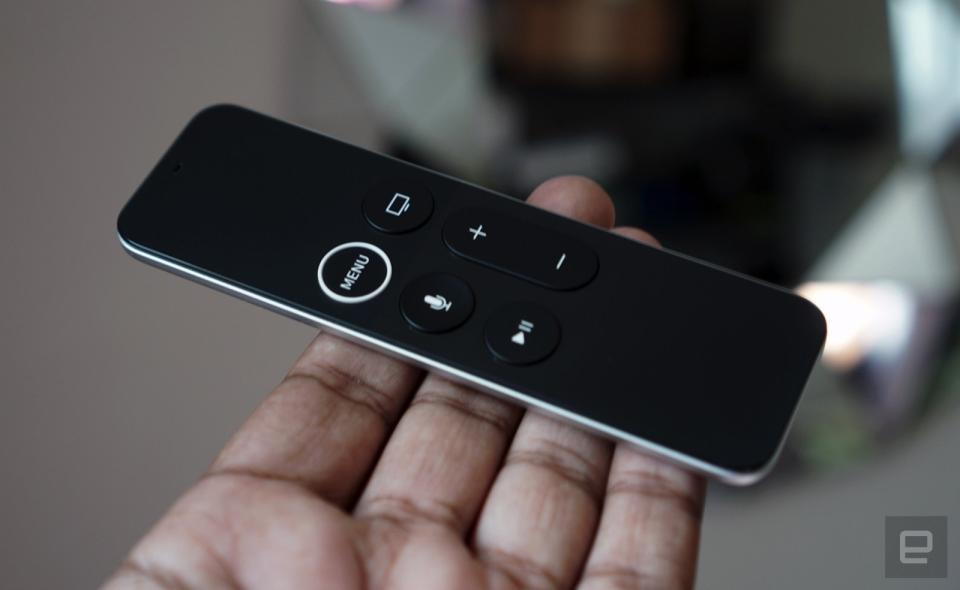
This new model won't win over haters of the original remote, who criticized its fragile design and touchpad controls. But as someone who actually liked the last model, I found it just as easy to use. It still doesn't make much sense to throw glass on a slim remote that'll inevitably get crushed in your couch, though.
Under the hood, the Apple TV 4K is powered by the A10X Fusion processor, the same chip inside of the newest iPad Pro models. That additional power is certainly helpful for dealing with huge video files, but it's also something that games and apps will be able to take advantage of. The last Apple TV often had trouble running complex apps -- like Sling TV and Hulu (with its redesigned interface) -- without any slowdowns.
Software and setup
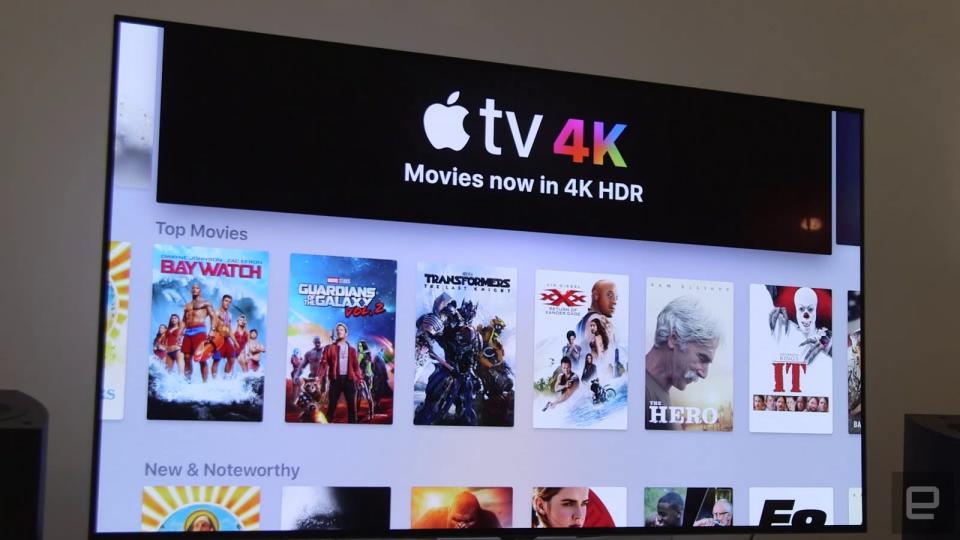
Setting up the Apple TV 4K was pretty simple: Just plug in your WiFi credentials, enter your iCloud account, and you're good to go. If you have an iOS device nearby, you can also hold it near the Apple TV during setup to transfer all of your settings. The entire process took just a few minutes when I used my iPhone 6S.
Apple's tvOS platform hasn't changed much, but the company did add a new feature called "One Home Screen," which lets you sync up your apps and their layout across multiple Apple TVs. It worked flawlessly as I transitioned away from my previous-gen Apple TV (though I did have to manually enable it before I unplugged that model). You'll still have to log into all of your streaming services, but One Home Screen at least saves you the trouble of finding all of your apps and organizing them.
For the most part, tvOS still looks like a slightly blown up version of the iOS homescreen. It's an interface that's beginning to show its age, but it's still more attractive than Roku's and the Fire TV's. The entire UI is also rendered in 4K/HDR, something that no other set-top box is doing yet.
In use
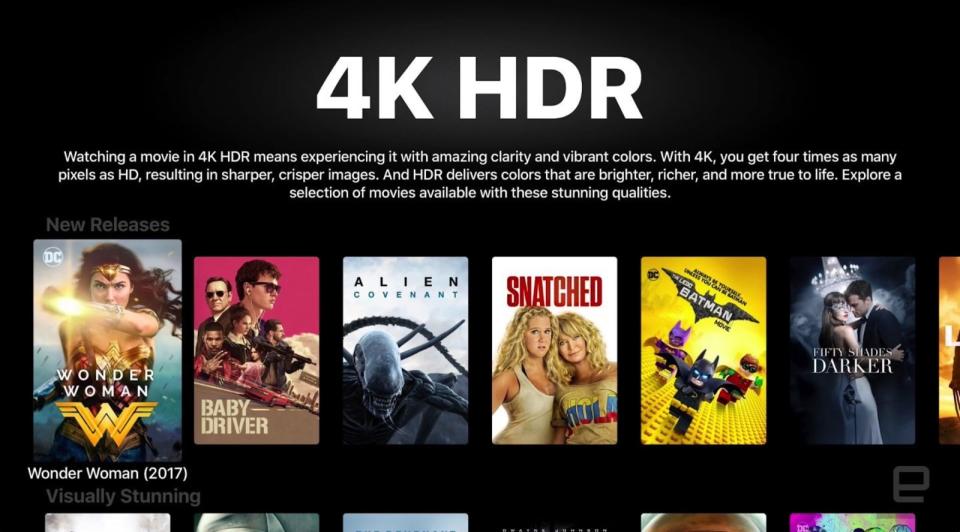
As you can tell by the name, the big difference with this new box is 4K support, which offers four times as many pixels as 1080p HD. That makes it ideal for bringing out very fine detail, like individual strands of hair and blades of grass. Most people won't be able to see much of a difference with the jump to 4K from their normal viewing distance -- you need to be sitting really close to a TV set 55-inches or larger to truly notice it.
Even if you have a massive TV, though, you'll notice the addition of HDR, or high-dynamic range video, more than 4K on its own. On compatible sets, HDR lets you see more intense brightness, deeper blacks and a wider range of colors in between. On newer films, the difference can feel like night and day.
Apple wisely chose to support both HDR standards: HDR10 and Dolby Vision. But, in typical Apple fashion, it's offering these new formats in a slightly different way. Unlike most devices, which enable HDR when you're watching video that supports it, the Apple TV 4K always has HDR enabled. Apple says this helps to avoid annoying flickering that occurs on some TVs when they switch in and out of HDR modes. It might seem like a strange choice, but as Apple sees it, forcing HDR solves a fairly common usability issue. Some TVs take several seconds to jump into HDR mode -- something that feels unconscionable in 2017.
By default, Apple says it forces the best HDR setting for your TV set. The definition of "best," is up for debate, though. On my LG OLED B6, it automatically enables HDR10 at 60Hz. But I'd prefer to be viewing in Dolby Vision, since it can adjust to changes in lighting dynamically, something HDR10 can't do. Since I had no trouble watching Dolby Vision titles, it appears as if the Apple TV is doing some sort of automatic translation between HDR modes. You can force the Apple TV to display specific resolutions and refresh rates, but at this point you can't choose which HDR mode to output. We've asked Apple for more details about how it's handling HDR, and will update if we hear back.

For now, the only 4K/HDR enabled content Apple is offering is in the iTunes Movies app. There's a section dedicated to the higher resolution films, with a slim offering of more than 120 titles. That's on-par with Vudu's 4K library, Apple's biggest competitor. Surprisingly, There aren't any 4K/HDR TV shows on iTunes yet.
While adding 4K/HDR support is nice, it's nothing revolutionary. What is transformative is that Apple isn't charging a premium for 4K films. You'll be able to buy them between $15 and $20, and rent them for $6, just like the company's current HD library. And just as the company promised, your existing iTunes purchases will be upgraded to the new format for free. In my library of 50 films, my copies of Star Trek Beyond, Arrival, The Lego Movie, Kingsman, and La La Land were all instantly bumped up.
We're already seeing the impact of Apple's pricing on the rest of the streaming market: Google and Vudu have both started discounting 4K titles. Vudu used to charge $30 for 4K purchases and $10 for rentals. While the competition isn't offering free 4K upgrades yet, it seems like it's only a matter of time until they follow suit since they were so quick to match Apple's prices. So even if you're not even interested in the Apple TV 4K, you've got Apple to thank for pushing everyone towards sensible pricing. Given that most consumers are used to watching media via subscription services, it seems wiser to lower the cost so they don't get turned off of digital purchases and rentals completely.

So how do the souped-up movies look on the new Apple TV? In a word, fantastic. Kong: Skull Island ended up being the ideal 4K HDR demo on my LG OLED TV set. It features scenes with plenty of bright elements, as well as detailed dark portions. At times, both extreme brightness and darkness show up at the same time, thanks to the versatility of HDR. I had to shield my eyes a bit when Kong stands in front of the bright tropical sun, but I could still make out details in his dark fur. The film's many explosions, not to mention other giant monsters, also looked incredible thanks to all of the new video technology.
Quality-wise, Kong looked on-par with what I've seen from Vudu's 4K streaming, but there was still the occasional compression artifact. That's simply the reality of streaming video, though -- if you want to be rid of blocky compression completely, you'd have to upgrade to 4K Blu-ray discs. When comparing the ITunes 4K version of Arrival to my 4K Blu copy, I didn't notice any significant differences, aside from the occasional artifact on the streaming side.
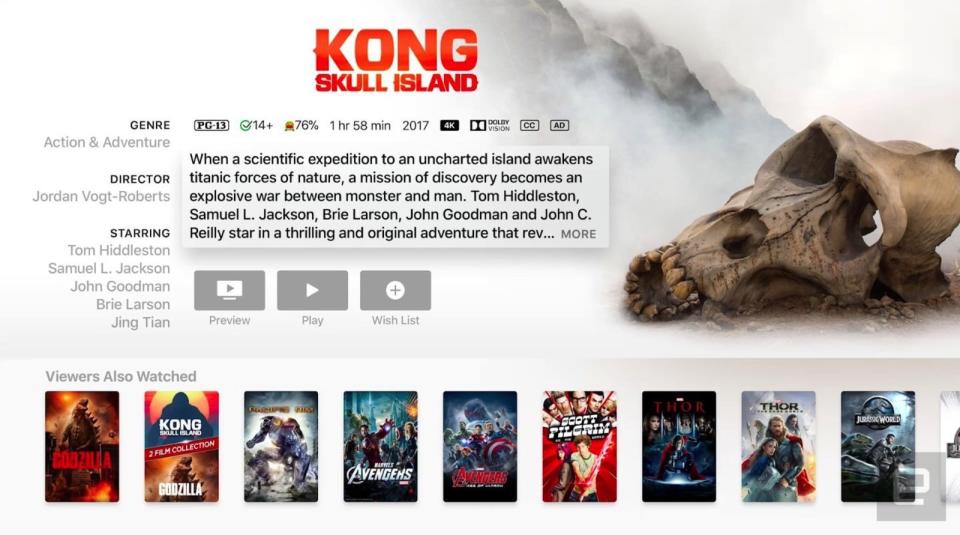
Baby Driver is a much brighter film than Kong, but its colorful palette almost pops off the screen with 4K/HDR. The formats also help with the film's many action sequences -- there was a bit more oomph as every gun fired, and I could make out even more detail during the long chase sequences. In many ways, the film looked more impressive than it did in an actual theater.
The Apple TV also surprised me by how quickly it loaded up 4K films. Typically they'd launch in less than a second, and most of the time they also loaded up in 4K from the start. With Vudu, it would typically take a second or two before things got started. That's not a huge difference, but it makes for a practically seamless viewing experience. Apple recommends that you have at least a 25 Mbps internet connection to stream 4K, which should technically be doable for many consumers in the US. I'd also recommend using a modern 802.11ac router to push all of that data -- things could easily get stuttery on older gear.
On Netflix, I ran through my usual 4K/HDR demos and came away impressed. Daredevil, a show that tends to be very dark, looked just as good as it did on my TV's built-in app. The new formats come in especially handy for the show's night-time fight scenes -- on my old 1080p plasma set, it was sometimes difficult to make out the intricacies of its incredible choreography. And I could almost taste the gorgeous meals on Chef's Table.
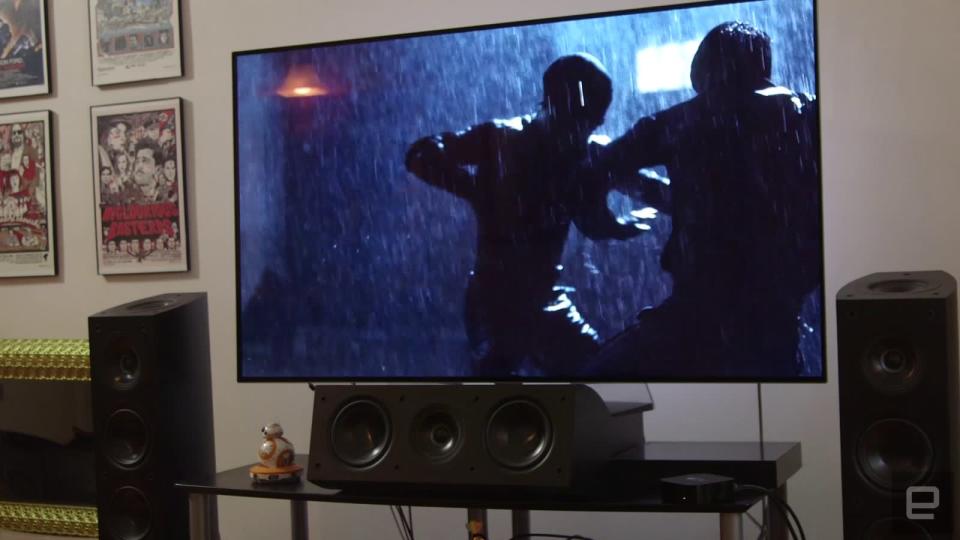
Unfortunately, the Apple TV 4K is still way behind when it comes to third-party support. Netflix is the only app with 4K/HDR enabled today. There's an Amazon Prime Video app coming, which will likely include that service's UHD titles . There's no 4K YouTube support either, because Apple hasn't adopted Google's open VP9 codec. Given that YouTube is home to plenty of 4K video, it's something both companies will want to fix soon. Hulu also offers 4K streaming on game consoles, and Apple says it's in talks with enabling that on the TV. And of course, there's the recently launched Vudu app, which is also stuck with HD titles.
There weren't any new games to show off, but Transistor did run a bit more smoothly than on the last model. In the future, you can look forward to Sky, the next game from Journey creator Jenova Chen, as well as an adaptation of the creepy indie game Inside. Apple TV's gaming ecosystem has floundered the past few years, but the added horsepower here might help it recover. It could give developers just the push they need to port their games over without compromises.
Of course, there's still plenty of room for Apple to improve. Its 4K library is missing major films from studios like Disney and franchises like The Fast and the Furious, and the company clearly needs to get more 4K-enabled services aboard. I also noticed some weird quirks with the Apple TV's video processing -- for some HD shows on Sling and HBO Now, it tended to over-emphasize sharpened edges and some lighting elements. It'd be nice to be able to turn off that image correction completely.
Perhaps strangest of all, the Apple TV 4K doesn't support next-generation audio formats like Dolby Atmos and DTS:X yet. That's something plenty of devices, including the Xbox One S and lower-end Roku boxes, have offered for a while now. Netflix is also offering it with some newer releases, like the film Okja. Apple says Atmos is coming eventually, according to The Verge, but it's unclear when we should expect it. I'm currently running a 5.1.2 (5.1 with two upward firing speakers) Atmos configuration, and it's simply disappointing that such a high-end device can't take advantage of it properly.
Pricing and the competition
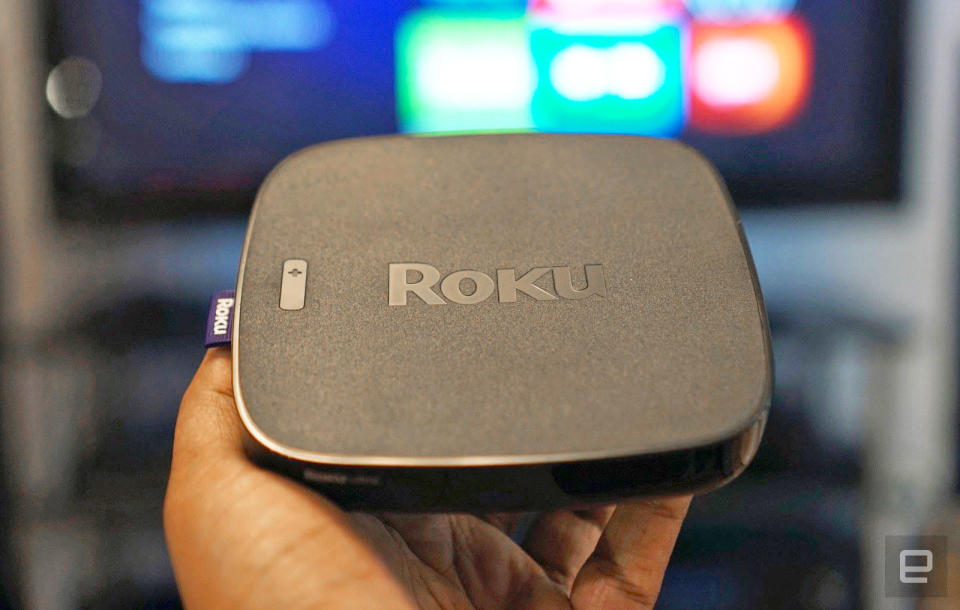
The Apple TV 4K starts at $179 for the 32GB model, up from $149 for the last version. There's also a 64GB model for $199, but that's mainly meant for people who plan to download plenty of games. In comparison, you'd have access to more 4K HDR content with a $100 Roku box or Amazon Fire TV.
The very idea of using a set-top box is beginning to seem anachronistic, now that more TVs are including most of the popular streaming apps. But the Apple TV's ease of use, together with iTunes' inexpensive 4K offerings and free upgrades, makes the case for investing in a separate device.
Wrap-up
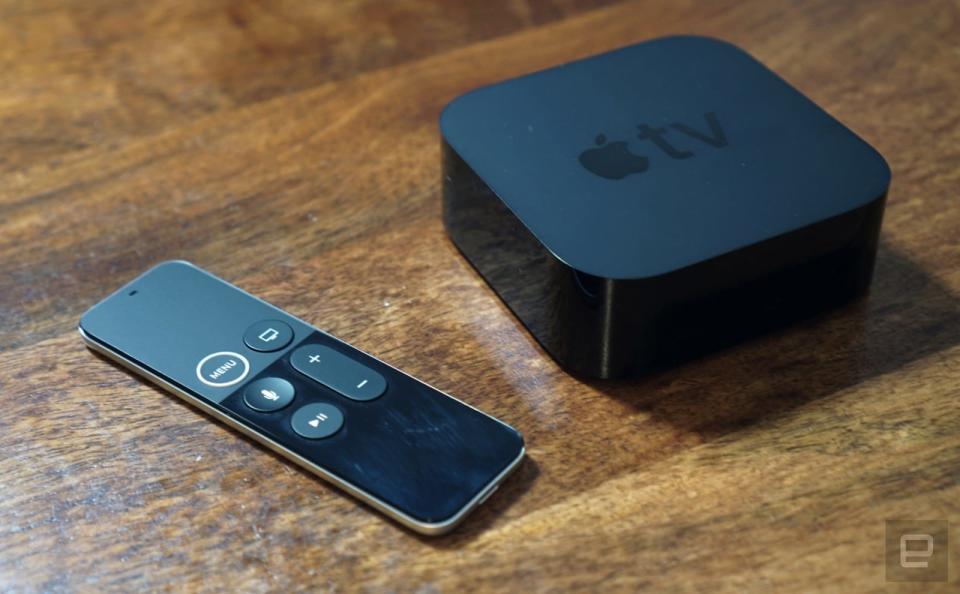
The Apple TV 4K does everything you'd expect it to do -- what's surprising is how Apple is undercutting the competition in 4K pricing. In a world where people are buying fewer films, and the current best physical media format might not be sticking around for long, it serves an important role by making 4K and HDR films more accessible. It's just a shame that we still have to wait for Apple to score more licensing deals, get more third-party support and fix curious omissions, like its lack of Atmos support.










